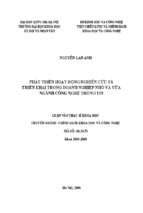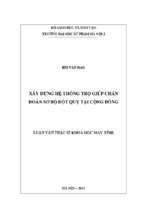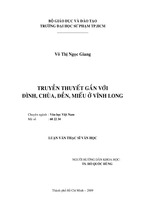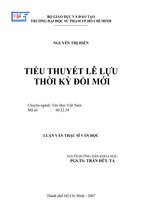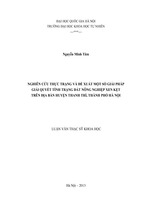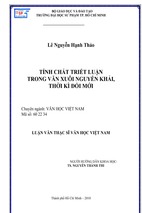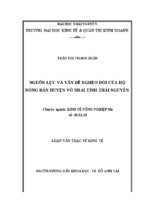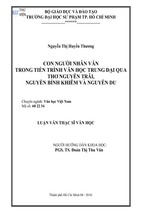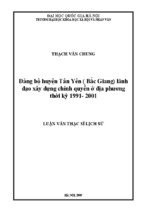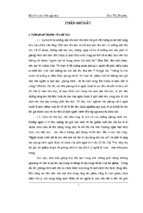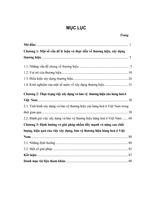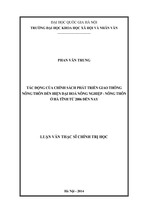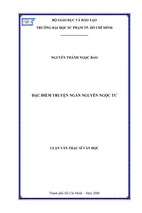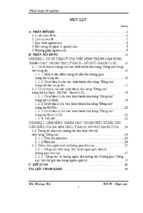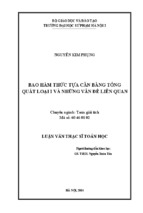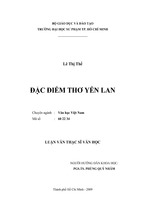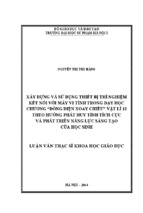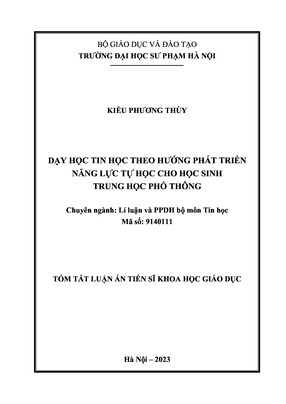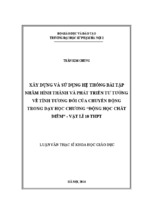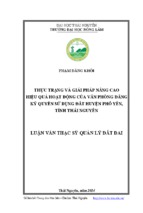VIETNAM NATIONAL UNIVERSITY, HANOI
UNIVERSITY OF LANGUAGES & INTERNATIONAL STUDIES
FACULTY OF POST- GRADUATE STUDIES
--------***-------
NGUYỄN THỊ LAN ANH
AN INVESTIGATION INTO STUDENTS’ RETICENCE IN
ENGLISH SPEAKING LESSONSA CASE OF TOAN THANG HIGH SCHOOL
(ĐIỀU TRA VỀ TÍNH TRẦM LẶNG CỦA HỌC SINH TRONG CÁC GIỜ
NÓI TIẾNG ANH - ĐIỂN CỨU TẠI TRƯỜNG THPT TOÀN THẮNG)
M.A. MINOR PROGRAMME THESIS
Field: English Teaching Methodology
Code: 60.14.01.11
Supervisor: Dr. ĐỖ THỊ THANH HÀ
HANOI, 2014
VIETNAM NATIONAL UNIVERSITY, HANOI
UNIVERSITY OF LANGUAGES & INTERNATIONAL STUDIES
FACULTY OF POST- GRADUATE STUDIES
--------***-------
NGUYỄN THỊ LAN ANH
AN INVESTIGATION INTO STUDENTS’ RETICENCE IN
ENGLISH SPEAKING LESSONSA CASE OF TOAN THANG HIGH SCHOOL
(ĐIỀU TRA VỀ TÍNH TRẦM LẶNG CỦA HỌC SINH TRONG CÁC GIỜ
NÓI TIẾNG ANH - ĐIỂN CỨU TẠI TRƯỜNG THPT TOÀN THẮNG)
M.A. MINOR PROGRAMME THESIS
Field: English Teaching Methodology
Code: 60.14.01.11
Supervisor: Dr. ĐỖ THỊ THANH HÀ
HANOI, 2014
DECLARATION
I hereby state that I, Nguyễn Thị Lan Anh, being a candidate for the Degree
of Master of Arts, accept the requirement of the University relating to the retention
and use of M.A. Thesis deposited in the library.
In terms of these conditions, I agree that the origin of my paper deposited in
the library should be accessible for the purpose of study and research, in accordance
with the normal conditions established by the librarian for care, loan, or
reproduction of the paper.
Haiphong, July…….2014
Signature
Nguyễn Thi ̣Lan Anh
i
ACKNOWLEDGEMENTS
First of all, I would like to express my heartfelt gratitude to my supervisor,
Dr. Đỗ Thị Thanh Hà, for her valuable advice, constructive comments, patient
support and encouragement in the completion of this M.A. Thesis.
I would like to send my sincere thanks to my informants in this study, whom
I selected as the target subjects of this research. Without their enthusiastic
contribution and cooperation, this research would certainly not have been
completed.
In the thesis, it is inevitable that the ideas of many other writers in this field
are reflected and developed. Their ideas have stimulated my thinking on doing this
paper. My debt to the authors listed in the references is equally great. To all these
scholars, I offer my sincere thanks.
Finally, I am greatly thankful to my family and friends, who are forever a
great source of support and encouragement.
ii
ABSTRACT
Realizing many 11th graders at Toan Thang high school being passive in
English Speaking classes, this study aims to explore students‟ perception toward
their reticence behaviour in real- world classes, factors contributing to it and
students‟ expectation. A total of 373 students enrolled in eight 11th grade classes,
were first observed in eight English Speaking lessons, and then filled in two sets of
open-ended questionnaire. After that, six of them were interviewed using semistructured format. A mix- method analysis is conducted to explore the findings.
From the study, it is revealed that students have strong willingness to participate in
English activities though they rarely do so in reality due to various learning
misconceptions. The result indicates that teachers need not only to use interesting,
various and suitable activities to encourage students to learn the target language but
also to explain and have more informal talks with students to teach them how to
learn effectively.
iii
TABLE OF CONTENTS
DECLARATION .........................................................................................................i
ACKNOWLEDGEMENTS ....................................................................................... ii
ABSTRACT .............................................................................................................. iii
TABLE OF CONTENTS ...........................................................................................iv
LIST OF ABBREVIATIONS ....................................................................................vi
LIST OF TABLES AND GRAPHS ......................................................................... vii
PART A: INTRODUCTION ......................................................................................1
1. Rationale .........................................................................................................1
2. Aim of the study ..............................................................................................2
3. Research questions ..........................................................................................2
4. Scope of the study ...........................................................................................2
5. Methods ...........................................................................................................3
6. Design of the study..........................................................................................3
PART B: DEVELOPMENT .......................................................................................4
CHAPTER 1: LITERATURE REVIEW ....................................................................4
1.1.
Reticence behaviour in foreign language class ...........................................4
1.1.1.
The concept of reticence ......................................................................4
1.1.2.
Interpretation of reticence ...................................................................5
1.1.3.
Consequences of reticence ..................................................................6
1.2.
Students‟ reticence behaviour in English speaking lessons ........................7
1.2.1.
Students’ participation in verbal interaction ......................................7
1.2.2.
Potential obstacles to students’ verbal participation ..........................8
1.2.3.
Teachers’ roles towards students participation ..................................9
CHAPTER 2: RESEARCH METHODS OF THE STUDY .....................................11
2.1.
Participants and setting of the study .........................................................11
2.1.1.
Participants .......................................................................................11
2.1.2.
Setting of the study ............................................................................11
2.2.
Data collection ..........................................................................................13
2.3.1.
Data collection instruments...............................................................13
2.3.2.
Data collection procedure .................................................................16
2.3.3.
Data analysis procedure ...................................................................18
CHAPTER 3: FINDINGS AND DISCUSSIONS ....................................................19
3.1.
Findings .....................................................................................................19
3.1.1.
Students’ reticence behaviour in English Speaking classes ..............19
3.1.2.
Factors affecting students’ behaviour ...............................................24
3.1.3.
Students’ expectation .........................................................................29
3.2.
Discussions ................................................................................................30
iv
3.2.1.
To what extent do the students remain reticent in English speaking
classes, and what activities make them the most reticent? ...............................31
3.2.2.
What are students’ perception of their own learning behaviour and
factors influencing such behaviour? .................................................................31
3.2.3.
What are students’ perspectives on whether, and how, to move the
classroom to a more interactive mode? ............................................................32
PART C: CONCLUSION .........................................................................................34
1. Conclusion.....................................................................................................34
2. Pedagogical implications ..............................................................................36
3. Limitations of the study ................................................................................37
4. Suggestions for further study ........................................................................38
REFERENCES ..........................................................................................................39
APPENDIX 1: OBSERVATION TRANSCRIPT .................................................. I
Observation Transcript 1 ..................................................................................... I
Observation Transcript 2 ................................................................................ VIII
APPENDIX 2: QUESTIONNAIRE (English) -Part 1 ........................................ XV
APPENDIX 3: QUESTIONNAIRE (English) -Part 2 .................................... XVIII
APPENDIX 4: QUESTIONNAIRE (Vietnamese) -Part 1 ............................... XXI
APPENDIX 5: QUESTIONNAIRE (Vietnamese) -Part 2 .............................XXIV
APPENDIX 6: INTERVIEW QUESTIONS (English) ................................ XXVII
APPENDIX 7: INTERVIEW QUESTIONS (Vietnamese) ............................XXIX
APPENDIX 8: DETAILED ANALYSIS RESULT FOR GRAPH 1 .............XXXI
APPENDIX 9: DETAILED ANALYSIS RESULT FOR GRAPH 2 .......... XXXIV
APPENDIX 10: DETAILED ANALYSIS RESULT FOR GRAPH 3 ......... XXXV
v
LIST OF ABBREVIATIONS
CLT
Communicative Language Teaching
EFL
English as a Foreign Language
ELT
English Language Teaching
Ss
Students
T
Teacher
vi
LIST OF TABLES AND GRAPHS
TABLE 1
Data collection procedure in brief
Page 18
GRAPH 1
Students‟ self evaluation- The frequency of
Page 22
attending English Speaking Activities
GRAPH 2
Students‟ real participation in class
TABLE 2
Students‟ self evaluation- The frequency of
Page 24
XXXI
attending English Speaking Activities (with
Mean, Mode, Median, Standard Deviation, pvalue and Standard Deviation formula in excel)
GRAPH 3
Students‟ evaluation of main factors affecting
Page 26
their reticence
TABLE 3
Students‟ self evaluation- The frequency of
XXXII
attending English Speaking Activities (with
Correlation coefficient formula)
TABLE 4
Students‟ self evaluation- The frequency of
XXXII
attending English Speaking Activities (with
Spearman- Brown correction formula)
TABLE 5
Students‟ real participation in class (with p-
XXXIV
value formula)
TABLE 6
Students‟ evaluation of main factors affecting
their reticence
vii
XXXV
PART A: INTRODUCTION
1. Rationale
Because of the increasing status of English as a world language, people in
Viet Nam in general and in my hometown of Tien Lang in particular are becoming
more and more aware of the importance of the spoken English. This awareness was
reflected not only during many daily informal talks but also officially in the national
English language curriculum (MOET, 2006) which required high school students to
be able to conduct conversations in English on familiar daily life topics. Despite this
expectation, many high school students have been observed to be either quiet,
uncooperative or to speak English with a trembling voice, make numerous
unnecessary pauses, or have shaking hands or legs, etc. during the lesson.
This study was motivated by my concern about the apparent reluctance of
Toan Thang high school students to participate in English- speaking class
interactions. The decision to look into students‟ reticence at Toan Thang high
school was first inspired by my teaching and living experience with the students in
this school for more than three years. Such contact not only allows a valuable
rapport with members of this case but also encourages my interest in further
understanding students‟ perception and expectation. Initial observations at the
selected location reveals that spontaneous discourse was rare in many English
speaking classes and many oral interactions not only did not include any students‟
individual thoughts or elaborated responses but also fostered a great deal of
dependence on the teacher. As a result, both teachers and students have become
frustrated and often complained about the quality of the learning outcome. This
makes it urgent to examine this phenomenon to better understand the learning
situation at Toan Thang high school and ultimately enhance the learning and
teaching of oral English here. The second reason is my realization that students
themselves and students in different context (both educational context and
1
background) exhibit different behaviour and worldviews, which would contribute
diverse perspectives, experiences and insights into the topic of reticence. The above
reasons actually drive the researcher to a study thesis, namely “An investigation
into students’ reticence in English speaking lessons - A case of Toan Thang high
school”.
2. Aim of the study
The current study aims at:
Exploring the nature of students‟ reticence in English speaking lessons at
Toan Thang high school and some common situations for reticence to
flourish,
Investigating students‟ viewpoints of their own learning behaviour and
potential obstacles to their verbal participation in the classroom,
Finding out students‟ aspiration on whether, and how, to move the classroom
to a more interactive mode.
3. Research questions
(1)
To what extent do the students remain reticent in English speaking classes,
and what activities make them the most reticent?
(2)
What are students‟ perceptions of their own learning behaviour and factors
influencing such behaviour?
(3)
What are students‟ perspectives on whether, and how, to move the classroom
into a more interactive mode?
4. Scope of the study
Within the framework of a minor M.A. thesis, the researcher only focuses on
the real situation of reticence happening among 11th graders in their English
speaking lessons at Toan Thang high school, as well as their various angles and
desires towards this issue.
2
5. Methods
To achieve the aims mentioned above, the study adopts the methodological
approach of a survey study using mixed methods for data collection. The tools for
data
gathering
include
class
observation,
semi-structured
interview
and
questionnaire.
6. Design of the study
There are three main parts in the thesis:
Part A: Introduction, which presents the rationale, aims, scope and research
questions.
Part B: Development of the research which includes:
Chapter 1: Literature Review, which reviews theoretical foreground from the
previous studies on students‟ reticence behaviour in general and in English speaking
classes in particular.
Chapter 2: Research Methods of the Study, which composes of 3 parts: the
fitness of case study to the research purpose, participants‟ description and setting of
the study (the case), and data collection.
Chapter 3: Findings and discussion, which is the discussion of the findings
through an analysis of the data collected through means of researching:
observations, semi-structured interviews and questionnaire.
Part C: Conclusion, in which major findings of the study will be briefly
summarized as well as the acknowledgement of the limitations of the study will be
elaborated.
Besides, the classroom transcripts, interview transcripts, questionnaires and tables
of data analysis results are included in the Appendices.
3
PART B: DEVELOPMENT
CHAPTER 1: LITERATURE REVIEW
1.1.
Reticence behaviour in foreign language class
1.1.1.
The concept of reticence
The terminology of reticence in academic writing was first introduced in
1965 with Phillips‟ article introducing to the field of speech communication and the
notion that some people had difficulty communicating across a range of situations.
After his groundbreaking contribution, reticence caught the attention of many
researchers and linguists under different cognate constructs such as reticence
(Keaten
&
Kelly,
2000),
communication
incompetence,
communication
apprehension (McCroskey, 1970) and unwillingness to communicate (Burgoon,
1976). Their studies, no matter how different they were, agreed with Keaten and
Kelly on an affirmation that reticence was a communication problem with
cognitive, affective and behavioral dimensions and was due to the belief that one
was better off remaining silent than risking appearing foolish. (Keaten & Kelly,
2000)
My own standpoint of reticence is strongly influenced by Keaten & Kelly‟s
affirmation, which has been narrowed down to a specific situation- English
Speaking classroom. Reticence, in this paper, refers to behaviour of reticents who
have a tendency to avoid communication, that is, to engage in chronic silence out of
fear of foolishness. They remain silence as a patterned response to the threat of
negative evaluation. The feeling of uneasiness, worry, nervousness and
apprehension experienced by non-native speakers when learning or using a second
or foreign language has now changed learners into reticents since they possess a set
of faulty beliefs about communication and foreign language learning process.
4
1.1.2.
Interpretation of reticence
Since the beginning of reticence research, theories have been made relating
to what involved in reticence behaviour, and who often reveal themselves as
reticents.
First of all, reticence can indicate shyness characteristic. It includes attitudes
and feeling such as a lack of confidence particularly in new or unfamiliar social
settings, excessive preoccupation with self in the presence of others, inadequate
social skills, and disruptive anxiety and self-derogation in social situation. (Cheek &
Watson, 1989)
Second, reticence may imply too much inner speech overlapping one
another, which is conductive to depression, morbidity and anxiety (Tomlinson,
2001).
Third, reticence can communicate acceptance of the other person, but
without any doubt or any critical argument, which reveal passivity, lack of
creativity, shortage of knowledge, justification and inventive skills.
More often, reticence brings to light the fact that such people have no interest
on the situation they are involved. It can also be a token of not understanding, which
might be resulted from being involved in conversation or lessons with complicated,
difficult or above- level topics.
In addition, most people experience occasional feelings of shyness as a
transitory reaction when encountering certain difficult social situation. (Russel,
Cutrona & Jones, 1986; Zimbardo, 1977). Likewise, some individuals are fearful
and nervous of any unprepared situation that may cause unexpected results. They
can‟t risk themselves for any uncertain challenge. (Ely, 1986; Liu & Jackson, 2008)
Again, the above correlations between environmental factors and
communication reticence were detected and proved by many linguists‟ studies. The
results indicated that reticence is significantly influenced by antecedent
environmental factors, thus lending support to etiological explanations based on
learning theory and perception theory.
5
1.1.3.
Consequences of reticence
In many cases, the reticence behaviour is not simply resulted from one or
several reasons in some certain situations, but more often, a final manifestation of
serial complicated reactions during interactions such as tension, inhibition,
awkwardness, painful self-consciousness, physical distress, and worry about being
evaluated negatively. It comes along with somatic anxiety symptoms such as upset
stomach, pounding heart, sweating, trembling or blushing, which can lead to
stressfulness and depression. If reticence is not treated carefully, it can have serious
repercussion for the reticents‟ heath themselves.
Reticence in a specific situation of foreign language classes resulted in a
series of failure. As involvement and participation are essential for language
acquisition, the more utterances the learners offer, the better their spoken language
is and vice versa. This phenomenon is known as „Matthew Effect‟, that is "rich get
richer, poor get poorer" (Chau, 1996). Students, who are actively involved, reported
higher satisfaction and higher persistence rates (Tsui, 1996).
Furthermore, the act of being silent, reluctant to participate or speak using
the target language has always been considered as the main source of frustration,
and failure for not only students but also instructors (Flowerdew & Miller, 1995;
Jackson, 2002), which is essentially important when the conceptualization of the
Communicative Language Teaching approach is implemented. This negative
behaviour or passive attitude disrupts not only instructional plan, it also makes it
hard for instructors to facilitate active learning among students. As a conspicuous
consequence, it restricts students from progress, and intended course learning
outcomes might not be achieved. Moreover, most of the time, instructors have to
struggle in exploring ways to break the uncomfortable silence in interaction in order
to minimize the feeling of discombobulating.
In short, students‟ reticence, withdrawal, or fear of interacting not only
deprives them of sharing what they know, but also deprives the teacher and
6
classmates of benefiting from it. Thus students‟ reticence has a vital influence in
teaching and learning process and there is a need for an individual, teacher and
classmate to reduce or eliminate such phenomena.
1.2.
Students’ reticence behaviour in English speaking lessons
1.2.1.
Students’ participation in verbal interaction
In spite of the growing expectation for verbal classroom participation in
second and foreign language learning situations, reticence research has captured the
attention of language theorists and educators in recent decades. From his
observation and experience of teaching the EFL speaking skills for more than 15
years, Hilde (2009) has noticed that most of the students who enroll in the English
Department of Qassim University have revealed reticence in speaking activities.
Non English major students in Saudi Arabia, similar to learners in foreign language
contexts (Jackson, 2002; Howritz et al, 1986), have been observed to be either quiet
or to speak English with a trembling voice, make numerous unnecessary stops, or
having shaking hands or legs, etc. during English lessons or oral English tests. The
same problem has also been observed in other Asian countries. Dick and Robinson
(1995, p. 5) reported that Malaysian students “preferred not to say anything during
lecture discussion sessions” and “if an instructor asked a question, the class would
become deadly silent”. Korean students “speak only when invited by their
instructors” and Japanese students are “nervous about asking questions in class”
because they are unsure if a question was appropriate and they would choose “to
ask questions after class, only with teachers” (Chen, 2003, p. 267- 268).
In Vietnam, many students, after over ten years of schooling toward
intellectual maturity, have not demonstrated their basic communicative skills;
rather, there is an identifiable reticence, a reluctance to speak out in class and an
apparent unwillingness of students to express themselves which, to outsiders, may
be construed as a lack of motivation or shyness (Bao, 2013). In the classroom,
7
Vietnamese students‟ culture of learning can be described as one in which students
depend heavily on the pedagogical tendency of many teachers to transmit
knowledge about the subject content (Bui, 2004).
This makes it urgent to examine this phenomenon to better understand the
causes of the students‟ reluctance to participate in the English language classroom
and ultimately enhance the learning and teaching of oral English there.
1.2.2.
Potential obstacles to students’ verbal participation
Originated from Burns and Joyce‟s identification (Burns & Joyce, 1997),
there are three sets of factors that might cause the reticence in classroom activities
involving speaking: cultural factors, linguistic factors and psychological/affective
factors. The cultural factor here is understood as cultural attributes of Asian
societies which are often cited as the main causes for such alleged behaviour of
reticence and passivity. It was then widened by Cheng (2003) who used the two
terms “result of Confucian culture and tradition” and “previous learning
experience” as well as Bao (2013) with a more general name of “external forces”.
Linguistic-
related
factor
is
secondly
mentioned
as
causing
reticence.
Manifestations of communication apprehension in the EFL have been reported by
Lucas (1984, as cited in Aida, 1994) and Foss & Reitzel (1988, as cited in Aida,
1994), giving support to the idea that “people experience anxiety and reluctance in
communicating with other people or in expressing themselves in a foreign language
in which they do not have a full competence” (Aida, 1994). Moreover, reticence
relates to self-esteem & self-acceptance and whoever possesses an introvert and shy
personality often reveals reticence in class, especially foreign language classes.
According to Hui (2011), a student‟s reticence in class not only reveals that
he/ she is unwilling to talk in certain circumstances; it could also indicate any of the
following symptoms:
(1) the student‟s apathy toward the topic at hand or to the learning process itself;
(2) the student who is not comprehending is overwhelmed, or is bored;
8
(3) the student is isolated from the learning community;
(4) the student has not learned the value or strategies of engagement or he/ she
does not appreciate or believe in that value.
Additionally, reticence can be the result of high tension beween the new
approach and learners‟ traditional perception (Jarvis, 1986; Little & Sanders, 1990).
To sum up, there are a variety of factors that lead students to being reticence.
These factors, however, may not operate in isolation and as Van Worde (2003, p.5)
affirms, but are likely to be intertwined.
1.2.3.
Teachers’ roles towards students participation
Teacher is considered to be the key factors that influence students‟ behaviour
in class. Such conclusion is supported by a study of 100 Vietnamese university
students. More than 90% of the respondents had studied English for at least eight
years before completing the survey that focused on causes of demotivation in
learning English, which may lead to reticence behaviour: “The largest source of
demotives was related to teachers”, “within the four demotive categories related to
teachers, teaching methods provided the largest source of demotives” (Tran &
Baldauf, 2007). Reticence can be influenced directly by the teaching methods,
questioning methods, error correction, English proficiency and characteristics of the
teacher or indirectly by teacher‟s belief, the classroom habits that he/ she formed to
the students and what he/ she often teaches the students besides the English
knowledge.
First of all, the fact that teachers themselves have poor English language
competence leads to students‟ boredom, tiredness, doubt and finally students‟
reticence. Le (2002) reported that despite the strong promotion of CLT, the lack of
appropriate in- service professional development meant that “teachers are generally
incapable of teaching English communicatively in their real- world classroom.
Instead, they spend most of their lesson time explaining abstract grammar rules and
guiding their students in choral readings.”
9
Secondly, it is teacher‟s misconception about students‟ ability that causes
students‟ consciousness of being underestimated or neglected, which finally leads to
reticence behaviour. A survey by Tomlinson & Bao (2004) demonstrated that many
teachers do not wish to change their methods, with more than half the respondents
not wishing to participate in intervention for change, and some refusing to believe
that the learners were willing to participate and refusing to believe in the potential
of learners to express themselves fluently in English.
On the other hand, in preparing their students for such exams, teachers fail to
implement communicative approaches in their classrooms and use teaching methods
relevant to the students‟ goals of passing the exams (Kim, 2006). Moreover, some
teachers seem to overuse their authority, which is considered a main source of
inhibiting students‟ verbal performance. Many teachers remain too conservative to
accept different ways of viewing the same issue (Bao, 2004).
In brief, the influence of the teacher‟s traditional role over students‟ attitudes
toward classroom participation is indicated in four main tendencies. One view
highlights teachers‟ unchallenged expertise and self- complacency as a cause of
poor teaching performance which leads to poor participation. Teachers‟ positive
qualities are a stimulus to active collaboration and enthusiastic participation. A
second view implies that teacher frequently helds misconception about students‟
potential, which is a possible reason for students‟ reticence in class. A third view
suggests that teachers‟ strong emphasis on the written test and high score prevent
students from actively involved in the Speaking lesson. Last but not least, teachers‟
overused authority is considered to be one factor that induces fear and silence
among learners.
10
CHAPTER 2: RESEARCH METHODS OF THE STUDY
This chapter is to present research methodology I choose to achieve the aims
and objectives of the study. It gives out thorough explanations of reasons for
choosing the research instruments, and clarifies specific way of getting information
through those instruments.
2.1.
Participants and setting of the study
2.1.1.
Participants
The voices to be heard in the study are those of 373 students, age between 17
and 18, from one intermediate level class (receiving four periods of English per
week) and seven preliminary level classes (receiving three periods of English per
week). Such levels were named by the school administration based on students‟
average score after each semester. The choice of 11th graders, which covered
between two and three years of learning experiences at this school, allowed the
students not only to discuss their present English classes but to reflect on the history
of studying in previous classes. Among 373 students being investigated, 193
students are male and 180 are female. Most of them come from poor or middleincome families in the rural area. Due to the lack of information and technology,
students have little chance to access English in different ways. Almost all the 11th
graders being investigated (96, 5%) have never met foreigners before and half of
them have no intention of continuing to use English after class or after graduation.
Only 21 per 373 students (5, 6%) plans to choose subjects in group D to enter
university and college. (Lương Trường Xuân, 2014)
2.1.2.
Setting of the study
The analysis was carried out as a case study of Toan Thang high school. This
is a state- run school located in Tien Lang district, which is about 30 kilometer from
11
- Xem thêm -


